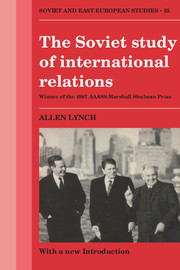Book contents
- Frontmatter
- Contents
- Foreword by Curt Gasteyger
- Acknowledgements
- INTRODUCTION: THE “ NEW POLITICAL THINKING” AND SOVIET FOREIGN POLICY: INTELLECTUAL ORIGINS AND POLITICAL CONSEQUENCES
- INTRODUCTION TO THE FIRST EDITION
- 1 THE BACKGROUND: MARX, LENIN, STALIN AND THE THEORY OF INTERNATIONAL RELATIONS
- 2 THE DEVELOPMENT OF SOVIET POLITICAL STUDIES
- 3 APPROACHES TO INTERNATIONAL RELATIONS
- 4 THE SYSTEMS APPROACH AND INTERNATIONAL RELATIONS
- 5 THE STRUCTURE OF THE INTERNATIONAL SYSTEM: THE SYSTEMS LEVEL
- 6 CRITICAL SUBSYSTEMS
- 7 THE SCIENTIFIC–TECHNICAL REVOLUTION AND THE CHANGING FACE OF INTERNATIONAL RELATIONS
- CONCLUSION
- Notes
- Bibliography
- Index
- SOVIET AND EAST EUROPEAN STUDIES
INTRODUCTION TO THE FIRST EDITION
Published online by Cambridge University Press: 05 August 2011
- Frontmatter
- Contents
- Foreword by Curt Gasteyger
- Acknowledgements
- INTRODUCTION: THE “ NEW POLITICAL THINKING” AND SOVIET FOREIGN POLICY: INTELLECTUAL ORIGINS AND POLITICAL CONSEQUENCES
- INTRODUCTION TO THE FIRST EDITION
- 1 THE BACKGROUND: MARX, LENIN, STALIN AND THE THEORY OF INTERNATIONAL RELATIONS
- 2 THE DEVELOPMENT OF SOVIET POLITICAL STUDIES
- 3 APPROACHES TO INTERNATIONAL RELATIONS
- 4 THE SYSTEMS APPROACH AND INTERNATIONAL RELATIONS
- 5 THE STRUCTURE OF THE INTERNATIONAL SYSTEM: THE SYSTEMS LEVEL
- 6 CRITICAL SUBSYSTEMS
- 7 THE SCIENTIFIC–TECHNICAL REVOLUTION AND THE CHANGING FACE OF INTERNATIONAL RELATIONS
- CONCLUSION
- Notes
- Bibliography
- Index
- SOVIET AND EAST EUROPEAN STUDIES
Summary
Whatever the political fate of the new General Secretary of the Soviet Communist Party and his program, it is clear that the current transition in political leadership in the Soviet Union is going far beyond a shift in personnel and involves the displacement of an entire generation of Soviet leaders even now fading from the scene with a younger, less experienced but in certain ways better prepared generation of Soviet politicians and their advisors. What, if any, changes might we expect in the thinking of this new Soviet leadership about the outside world? In truth, we really do not know. In the United States at least, few in either governmental circles or political science departments take what Soviet political analysts have to say about the broader world very seriously. Except for William Zimmerman's pathbreaking study of the Khrushchev period, we know little about how Soviet foreign policy intellectuals view the structure and tendencies of contemporary world politics.
Yet one would expect some changes of consequence to have taken place in the Soviet vision of the contemporary world, and not simply because of a change of political generations. Many of the conditions affecting the conduct of Soviet foreign policy, including both Soviet capabilities themselves and the structure of international relations in recent decades, have also changed, at times quite dramatically.
- Type
- Chapter
- Information
- The Soviet Study of International Relations , pp. 1 - 7Publisher: Cambridge University PressPrint publication year: 1987



